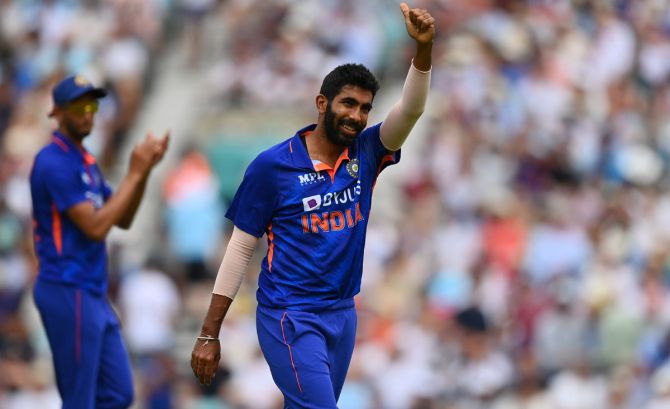If we have not been world beaters in cricket for the longest time, here is the reason: We look down on our bowlers and deify batsmen, argues Aakar Patel.

The British media and cricketers continue to whine about India's victory at Lord's over their women's team.
The controversy is about our Deepti Sharma running their last batter out at the non-strikers's end because she was leaving the crease. The law is quite clear here.
Indeed, it was clarified as recently as 2019 in R Ashwin's favour.
Under the previous MCC rule, bowlers were permitted to attempt to run out the non-striker only before entering their delivery stride.
Now, bowlers at all levels of cricket will be able to run-out the non-striker up to the instant at which they 'would be expected to deliver the ball'.
Deepti Sharma was condemned for following the rule.
The British sentiment is that she should have offered her opponent a warning before running her out.
Of course, batters have no obligation to warn or inform bowlers or 'keepers if they plan to step out of the crease on the next ball to clout it. Why is the bowler obliged to 'warn'?
The answer is, of course, that the bowler is a second class citizen in the commonwealth of cricket.
The rules are written and rewritten to undermine and deter him/her. We are often told that it's a batsman's game.
But the alacrity and enthusiasm with which the ICC are making life difficult for bowlers is disturbing.
The bowler can claim an LBW if the batsman's body comes between the ball and the stumps, but the law saves the batsman if the ball pitches outside leg stump or hits him outside off stump (a rule brought in the 1970s).
The front foot rule for fast bowlers changed in the 1960s, pulling the bowler further back into the crease.
The limitation on bouncers is more recent. The bowler is warned after the first one though dangerous injuries in top flight cricket have been very rare.
All sorts of field restrictions are imposed on bowlers, through the 30 yard circle and Power Plays and leg side limits.
ODIs have two balls, one at either end, to keep them harder and therefore making it easier to hit them farther.
Batsmen are constantly rewarded and bowlers punished through new rules like free hits, first for front foot no-balls and then, after 2015, all no-balls.
The rules punish errors by bowlers immediately -- no ball, wide ball etc -- but not those of batsmen (running on the pitch) who receive a couple of non-punitive warnings.
Batsmen can get runners, can come back immediately after retiring hurt, but bowlers cannot.
Bowlers can only bowl fixed numbers of overs in ODIs and T20s, but there's no limit on how many overs a batsman can bat.
There is no letting up on the assault against bowlers. Every new innovation seems to come specifically to undermine them.
The DRS system may be seen as a bowler's friend, but it is not.
A 2017 study showed that bowlers got a DRS decision in their favour 20% of the time, versus 34% for the batters.
Even the protocols of the system itself favour the bat over the ball: the batsman has to autonomy to ask for a review, but the bowler must appeal to his captain.
Batting tactics of all sorts -- switch hits, reverse hits -- are acceptable and indeed celebrated. Bowling tactics are looked as cheating.
Greg Chappell was within the law when instructing his brother Trevor to bowl underarm against New Zealand but he was excoriated and vilified.
Where the rules do not damage the bowler, the associations do. Australia banned the doosra in 2009, saying it was a chuck.
The other aspect is technology which is allowed unchecked when it comes to bats and other batting gear.
Dennis Lillee was criticised for coming out with an aluminium bat, but the modern bat is a bludgeon very different from the wood used by Bradman, Sobers and even Gavaskar.
Modern pads have an outer shell designed to ping the ball off them to maximise leg byes.
Cricket balls have remained the same for a century.
Indeed, bowlers have been begging in recent times to be allowed to play with the Duke's ball in Test cricket, because it is of higher quality and retains a strong seam even after wear.
But India continues to use another manufacturer, whose product our bowlers say does not meet the standard they expect.
The changes in bats and rules have punished the bowler in terms of the number of sixes hit in international cricket.
The most devastating batsman of the modern era, according to the greats who played him, is Sir Vivian Richards, who over a 15 year career hit 210 sixes.
It may surprise and dismay readers to know that he is only ranked 22 in the list of all time six hitters.
All the 21 batsmen who have hit more sixes than Richards have played after him.
In fact the next most recent batsman on that list retired 15 years after Richards (who left in 1991).
The man immediately above Richards, and who is 21st on that list, is Marlon Samuels, hardly a player of the same calibre but helped along by tech and rule tinkering.
All this has produced damage. We must not think it has not.
Bowling has been looked down on from the time of Harold Larwood (it was Douglas Jardine who devised Bodyline but shamefully it was Larwood who was punished for it) to the Dalit cricketer Balu Palwankar.
In our country, where manual labour is despised, bowlers and bowling have suffered.
India has for long led the world in looking down on the bowler and the data here is absolutely clear.
Try making an all time Indian XI. The batting is world class (Gavaskar, Sehwag, Kohli, Tendulkar, Dravid), and the bowling is pedestrian.
Kapil Dev, Kumble, Harbhajan and Ashwin are our highest wicket takers.
The first three of them average around 30 runs a wicket, and are not in the same league as the Australians or the West Indians or the Pakistanis.
In the list of best all time Test bowling averages, the highest placed Indian bowler is ranked 35 (Jasprit Bumrah) the next one is ranked 72 (R Ashwin).
If we have not been world beaters in cricket for the longest time, here is the reason: We look down on our bowlers and deify batsmen.
We have been brought up on the cliche that the benefit of doubt must always go to the batsman. But why?
Aakar Patel is a columnist and writer and you can read Aakar's earlier columns here.
Feature Presentation: Aslam Hunani/Rediff.com











